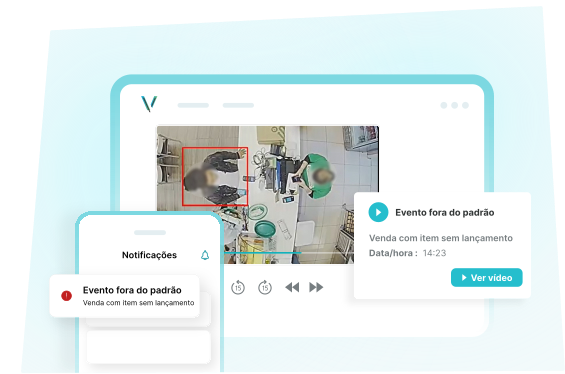For years, our team of engineers and psychologists has been immersed in the key challenges facing the physical retail industry, listening to and observing professionals who face these challenges every day. Countless conversations with store managers, frontline employees, and franchisees have revealed a fundamental truth: technology enables today's retail industry to achieve Michelin-starred operational excellence—making it both easier to manage and more profitable.
This realization didn't emerge overnight, but it solidified gradually. On the one hand, one of our co-founders brought 20 years of store operations expertise to the team. At the same time, we've spent the last seven years experimenting with technology, supporting operators week after week, and learning through trial and error what truly makes a difference in a store's performance.
What we discovered was indisputable. When stores implemented the fundamental principles of what we now call Precision Retail, their profits grew exponentially—in some cases, up to 341% in four months. More than just the numbers, we saw happier employees, less stressed managers, and more confident franchise owners.
All of this led us to an obvious question: why aren't all store owners experiencing these transformative results?
What is Precision Retail?
Precision Retail is a methodology focused on prioritizing resources and efforts to maximize return on investment (ROI) in physical stores. In other words, precision retailing brings to physical retail the same level of control and learning speed that we've long seen in e-commerce.
Traditional retail management follows a linear approach—adding tasks upon tasks to a growing list every day, without strategic prioritization. For every task crossed off, three more emerge. With every new technology and metric comes new responsibilities. The result? Overwhelmed operational professionals with a daunting amount of work and no clear path for improvement.
Precision Retail breaks this cycle by replacing this stacking of tasks with cyclical, mission-driven work. Instead of trying to do everything at once, it focuses energy on the activities with the greatest impact at any given moment, systematically improving store operations through targeted actions.
The eight fundamental principles of Precision Retail
1. Reliable data as a basis
Accurate and reliable data forms the foundation of Precision Retail. Without it, our ability to identify opportunities becomes blurred, prioritization efforts lose direction, and team guidance lacks clarity.
Quality data creates the momentum needed for operational excellence—allowing us to move forward with confidence rather than hesitation. When we build on reliable information, every decision gains strength and precision.
2. Access to good practices
Before defining your focus, explore what's already working well elsewhere. Identifying proven strategies early in the decision-making process creates a valuable reference collection of success stories.
This allows operators to confidently say, “This approach is delivering impressive results in other facilities—should we implement it here?” Increasing access to structured, documented best practices is not only helpful but essential for informed decision-making and effective prioritization.
3. Prioritization with strategy
With quality data and a collection of successful practices at your disposal, you can follow a method and identify where your efforts will have the greatest impact.
This is the critical moment to ask: "Among the opportunities we've identified, which one truly deserves our attention and resources right now?" Strategic prioritization transforms potential into focus, making it easier to direct energy where it matters most, rather than wasting it on multiple initiatives.
4. Define your cycles, rituals and roles
Operations thrive on structure—clearly defined cycles and rituals that everyone understands and anticipates. Your team needs clear roles, goals, and plans, with clearly assigned responsibilities.
This ensures that each team member recognizes their specific contribution to strategy execution. When everyone understands not only what to do but how their work fits into the broader operational rhythm, coordination happens naturally, not forced.
5. Command the mission
Once you've defined the priority, transform it into a single, focused objective that will unite your team. Mission leadership means translating the chosen opportunity into a tangible challenge to be solved, ensuring that frontline teams clearly understand why it matters and how they can contribute. Remember the power of repetition in communication and actively listen to confirm that your team truly understands the mission—not just hears it.
6. Shorten your learning cycles
With a well-defined and clearly communicated mission, it's time to accelerate the pace at which your team learns and adapts.
Balance the need for reliable performance data with the risk of employee overload. Effective learning cycles provide training that promotes improvement without burning out the team or undermining motivation.
The faster you can learn, adjust, and implement, the more responsive your operation will be.
7. Offer personalized and ongoing micro-training
Now that you've defined what to cover (mission), how to learn efficiently (short cycles), and when to reconnect (rituals), tailor the training to each person's specific needs.
The approach of microtreinamentos - short, personalized, and precise training - has already been successfully used in various areas of education, from executive courses to professional training. It ensures that employees effectively execute strategies and best practices based on real-life situations.
Focus on tailoring training to each team member, delivering it in short, practical segments that build competency without being overwhelming.
8. Be fair and uplift people
The heart of the Precision Retail is to create the conditions for people to reach their full potential—allowing the business to reach its own. When employees perceive fairness in processes and feedback, their engagement with the mission naturally deepens.
By intentionally highlighting the bright spots and maintaining a positive, growth-oriented approach, you cultivate a genuine belief in your team's capabilities and strengthen their commitment to excellence.
Remember that while systems and data provide structure, your most powerful catalyst for transformation isn't in spreadsheets or performance charts—it's in people, when they feel truly inspired to excel within a model that values their growth as much as business results.

Transforming Retail Operations: Real Results
The impact of Precision Retail can be impressive. We've seen stores increase their profits by 341% in just four months. Store groups have increased their average ticket value by 414%. When comparing franchisees who use this methodology with those who don't, we consistently find 30% to 40% higher revenue among adopters.
These quantitative results come from applying the core of Precision Retail: analyzing reliable data, identifying areas with high potential for improvement, focusing resources on these opportunities, and offering personalized training to employees.
But the qualitative impacts are no less powerful:
By receiving clearer instructions, frontline employees feel that someone is truly invested in their development. They feel heard and valued.
Store managers face a less overwhelming daily workload. Instead of trying to manage everything at once, they have clear missions and support to achieve them.
Store owners gain confidence that their operations are under control, with visibility into all aspects of performance and the peace of mind that improvement is continuous.
Within franchise networks, field consultants benefit from shorter learning cycles and data-driven insights to support multiple units more effectively. At the corporate level, COOs gain clarity on the system's overall needs and can create tactical plans for franchisee improvement.
Implementation: Starting the Precision Retail Journey
The transition to the Precision Retail It starts with a shift in mindset. Instead of the traditional linear approach to retail management—which continually adds tasks to an already impossible load—we adopt a cyclical, mission-driven perspective.
The first step is to establish reliable data sources. This usually involves aggregating information from different systems into a unified view of the operation. In franchise networks, this process becomes more efficient as the data architecture can be replicated across units.
Next comes the critical task of selecting the initial mission. This first cycle should focus on an area with high ROI potential and a strong probability of success. Initial wins build confidence in the methodology and generate momentum for subsequent cycles.
Implementation follows a four-week pattern: analyze data, set clear goals, identify best practices, develop customized training approaches, execute the plan, measure results, and then begin the next cycle with new learnings.
As with any transformative approach, adoption requires education and engagement. The educational challenge lies in helping operational professionals understand that, while this approach may be different at first, in the short term it generates less stress, simpler management, and better results.
Common implementation mistakes include incorrect prioritization in the first cycle (failing to generate a clear ROI that proves the concept) and inappropriate task allocation (without considering time constraints and scalability). For example, asking a franchisee with multiple stores to perform the same daily task across ten locations is unsustainable—roles and responsibilities must be aligned with practical realities.
The Future of Precision Retail
We are just at the beginning of what is possible with thePrecision RetailAs technology continues to evolve, each core element of the methodology becomes even more powerful.
First, our ability to measure the reality of stores will become increasingly sophisticated. Computer vision and other technologies will provide more accurate, frequent, and comprehensive data, further expanding our understanding of operations.
Second, AI-powered algorithms will dramatically improve our prioritization capabilities. As we gather more data on the effort required for different interventions and their likelihood of success, machine learning will help us more accurately identify the highest-impact opportunities.
Finally, behavioral change methodologies tend to become increasingly personalized and effective. Imagine a world where AI-enabled coaching systems transform learning into hyper-personalized instruction, with content tailored to each individual's learning style, performance patterns, and motivational triggers.
The result? Retail operations that combine the best of human creativity and judgment with the amplifying power of technology—creating environments where businesses and people thrive.
Is Precision Retail Right for Your Operation?
Although the Precision Retail While it can benefit any retail operation, it offers particular advantages to franchise chains due to the standardization of their operations. When multiple units face similar challenges, the learning cycle accelerates, as successful practices can be identified and scaled more efficiently.
That said, the core principles apply broadly. Any retail operation struggling with overwhelming to-do lists, unclear priorities, ineffective training, or difficulty maintaining consistent performance can benefit from this approach.
The ultimate measure of success is whether the methodology helps you achieve your goals. When we implement Precision Retailing, we don't just look at financial metrics. We ask a simple question: "What would you do if this approach ceased to exist tomorrow?" The answers tell us everything we need to know about its value.
Experience Precision Retail with Visio
Retail operations today face unprecedented challenges—from labor shortages to rising costs and ever-changing consumer expectations. But they also face unprecedented opportunities to transform the way they operate. The cost-benefit equation of operational control has fundamentally changed with modern technology, creating the possibility for physical retail to achieve the same level of precision and adaptability that e-commerce has enjoyed for years.
By adopting Precision Retail, operational professionals can cut through the noise, focus on what truly matters, and create environments where businesses and people thrive. The days of endless to-do lists, vague guidance, and generic training are over. The future belongs to those who can precisely direct their energy where it generates the greatest returns—for the business, employees, and customers.
Visio is an AI-powered platform that brings Precision Retail to the reality of your operations, with close support from experts. Our platform centralizes everything you need to see to ensure accurate management, from data to employee behavior, allowing you to seize opportunities for profitability improvements that you couldn't see before due to your busy schedule.
With Visio, you gain the level of control and visibility into your store's routine that you've always wanted, and you can direct concrete actions that will help you implement micro-training, replicate best practices, and see results faster.






